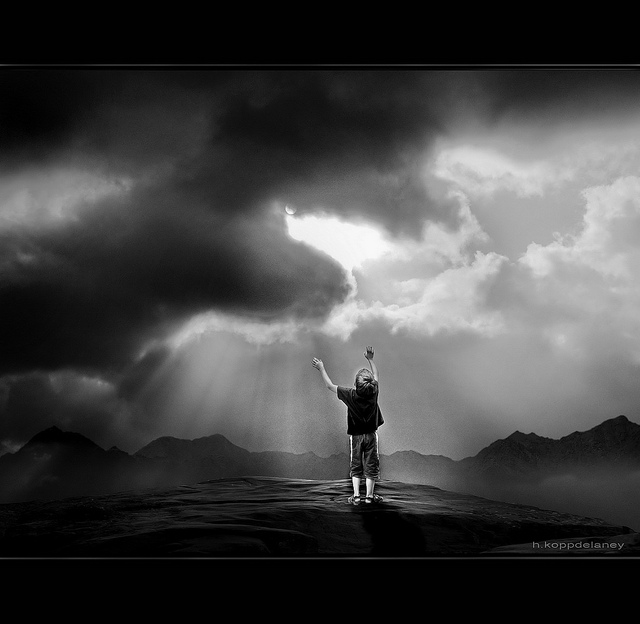In recent years we have witnessed the rise of anti-theism.
An “anti-theist” is usually someone who calls themselves an “atheist,” but does not limit their atheism to simply believing that there is no transcendent conscious dimension to existence. Rather, they attack religion, ascribe it to ignorance or childish impulses (e.g., fear of death, failure to take responsibility for one’s actions, a need to explain natural phenomena in the absence of science…), and blame it for virtually all mankind’s ills, including intolerance, hatred and war.
Besides poorly-researched beliefs about the actual socio-historical and psychological nature of religion and an uncritical lumping of the vast array of distinct religious traditions across the globe and throughout history, these “Atheist Fundamentalists” betray an adherence to an implicit dogma, which they mistakenly believe to be based on science.
And, while it is true that anti-theist dogmatists do forgo the comfort of a cosmic father figure or life after death, they also grant themselves the not inconsiderable satisfaction of certainty about the ultimate nature of reality and superiority over those less “rational” than they.
Science is heuristic, not ontological; it is a tool, not a worldview, designed to build practical models based on certain types of information. It is also empirical, although it is not the only empirical method for the accessing of knowledge about reality (meditation is an example of another). There are certain types of questions it cannot answer, and the limits of scientific knowledge are not necessarily coterminous with the limits of reality.
Further, the basic axioms on which science is ultimately based (e.g., “the world is rationally knowable,” “the world operates according to predefined regular laws,” “for an experiment to be valid it must be repeatable,” etc.) are themselves unproven and unprovable. They can either be understood as the rules of a game designed to give us an, at best, partial view of reality, or they can be taken irrationally as articles of faith.
We can understand science as a lens through which to view reality, a particular wave on the spectrum of information that we can capture and analyze in search of knowable patterns to existence, or we can make it into an Ultimate Truth, in much the way Christians view the Bible, or Muslims the Quran.
Like many a priori detractors of anything (e.g., Christian Colonizers of the “heathen” traditions of the peoples they colonized), anti-theists have some pretty negative and uncritical views of religion (“Religion is by definition dogma,” “Religion is an attempt to explain things that can better be explained by science,” “Religion is really about man’s fear of death, or man’s need for certainty, or man’s need for a Cosmic Parent,” etc.). Yet the definition of religion such people use is usually extremely limited, if not completely false, and frequently based on their own limited experience of some particular religion (usually Christianity).
The creation of a straw man (“Religion is…”) and its subsequent demolishing while ignoring the real phenomenon one purports to describe is a cheap rhetorical trick based on the logical fallacy that one can judge all religion by a sample as small as one or two. The main difference between such atheistic dogmatists and the religious dogmatists they rail against is primarily that, while the religious dogmatist feels a need to convert others, the anti-religious dogmatist is content to merely assert his intellectual and moral superiority over them.
Religion exists in all human societies and (like any universal aspect of culture, such as language, cuisine or marriage) everywhere responds to a basic human need: to connect us back to our source (“re-ligio” = “to relink” or “reconnect”); connect us to the meaning and essence of life; the ultimate grounding and unity of all Creation; and transcendence of the limited, particular and time-bound to the background against which all existence unfolds.
At its root, all religion thus speaks to a basic inner truth and performs an essential function in helping the individual “get right” with the world on the deepest level. Wonder, reverence, respect, devotion, humility, a sense of mystery, a radical grounding in the present, and the movement of consciousness beyond the bounds of intellect and the limited self, the leaving behind of ego… These are some of the inner feelings that such a “getting right” cultivates.
Religion is a symbolic language and, like all language, changes form across time and space. Religion speaks in poetry, not prose; it speaks to the soul, not the mind; it speaks of truth, not fact. In such a language, passion and resurrection, Hajj and Jihad, the Promised Land and the Temple, can be metaphors of personal transformation rather than descriptions of the physical world. Taking them literally—as something to impose upon the others rather than to cultivate within ourselves—can produce some very unpleasant results.
Even Jesus’s words can be twisted (“I came not to bring peace, but a sword…”). The Sacred by definition cannot be captured in words, but only evoked or hinted at. Fixating on any symbol, image, word, idea, rule, practice, or text—rather than the transcendent Truth these imminent forms point to—is the very essence of idolatry.
But religion can also become something else: an institution that legitimizes and maintains a given social order. Religions can give rise to organizations and develop a dimension of politics, power and social control; an outwardly-directed aspect focused not on the inner being but on society. In most religions, these two aspects, inner and outer, coexist in some kind of balance or dynamic tension.
Still it is probable that most religions begin with an inner experience of the Sacred, which is where they derive their attractive power. A ritual technology then develops around this experience to evoke it, and a body of myth to describe and explain it. Finally, social institutions begin to emerge around that body of ritual and myth that take on the worldly dynamics of human organizations—until some new reformer comes along to reignite the original experience of the Sacred and start the process again.
Jesus was one such reformer. His teaching was a critique of the religiosity of his time, which favored form over meaning—external appearance over inner attitude. What good, he asked, is following the law if you’re not a good person? The law is merely a means to bring one into contact with a more spiritually and ethically grounded way of being, but does not automatically confer that state of being any more than sitting in a lotus position can automatically replace the enlightenment of the Buddha.
People lose their way spiritually when they cling too tightly to the outer forms of their religion while losing sight of the deeper purpose behind the forms—in essence taking the means for the end. Jesus’ radical reform of Judaism was to replace the former’s focus on the law with a focus on the inner attitude (non-judgment, loving one’s neighbor as oneself, returning to the state of little children, taking no thought for the morrow, etc.). His teaching was essentially a shift from the letter to the spirit of the law.
But (most likely after his death), the teaching of Jesus got replaced by the teaching about the Christ. Suddenly all one had to do was believe that the Son of God died for their sins and rose again, and they would have eternal life. The law had been replaced by faith; belief in a doctrine, largely advanced through Synods and wars, and the focus on the inner attitude was again lost. (Of course, new inward seekers then arose—from the Gnostics to the Medieval Christian Mystics—to interpret even that myth symbolically, thus keeping inwardly based traditions alive even as the Church enjoyed great worldly power.)
Jesus spoke in parables. No one seriously asks whether the Prodigal Son or the Good Samaritan actually existed—what matters is the point of the story, the message for improving our own inner attitude. The story of the Christ can also be read in that way: less as a historical account than as a symbolic truth with the power to transform us. Is religion ultimately really about then and there or rather about here and now; about them or rather about us? Robert Graves defined poetry as “language that does something.” Isn’t the real point of myth and religious story to have an effect on us?
Take the scene of the crucifixion: Jesus on the cross with its four cardinal points, directly above the skull of Adam, one thief on each side (one going to Heaven; the other to Hell), the two Marys at his feet (one a virgin; the other a prostitute), etc. That is a very charged symbolic image. People have been inwardly transformed by contemplating that image. Does it really matter if it’s an accurate depiction of an actual historical scene?
There are ultimately no “good” and “bad” or “right” and “wrong” religions, but rather misinterpretations and misuses of it. It is not religion that is the problem, but rather the prosaic, literal reading of religion, and when it’s directed outward as a program for society or the world, rather than inward journey toward illumination of the deepest source of the inner being. This is neatly confirmed by the Atheist Fundamentalists, who make precisely the same mistake as religious literalists of reading religion as prose rather than poetry; fact rather than truth. The one reduces religion to dogma and believes it; the other reduces religion to dogma and dismisses it. Both are equally impervious to the Sacred, which is a living, transcendent reality that can only be felt within.
One can be religious and non-dogmatic or a dogmatic atheist; one can turn both science and religion from a method into a normative and exclusionary worldview. The fault, dear Brutus, is neither in science or religion, but in the way way approach them.
~
Relephant Favorite:
How To Be Religious.
~
Author: Peter Cohen
Editor: Travis May
Photo: Flickr/Hartwig HKD












Read 1 comment and reply